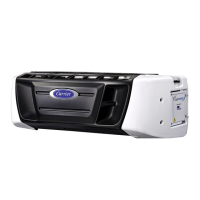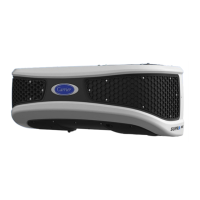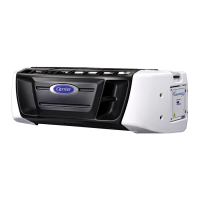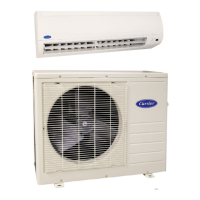Do you have a question about the Carrier Supra Series and is the answer not in the manual?
Details the unit's model, serial number, refrigerant, and service date for reference.
Cautionary notes regarding the Auto-Start/Stop feature and safe operation.
Warning about handling hot and pressurized engine coolant to prevent burns.
Precautions for handling refrigerants due to potential for frostbite or severe burns.
Safety advice for lead-acid batteries, including risks from flammable hydrogen gas.
Procedure for draining water and impurities from the fuel tank and checking fuel level.
Guidelines for checking belt tension and condition for optimal service life.
Checking electrolyte levels and ensuring battery connections are clean and tight.
Procedure for checking engine oil level using the dipstick.
Visual inspection for leaks, loose bolts, frayed wires, and coil cleanliness.
Checking truck body for damage, seals, and insulation integrity.
Steps to start the unit for road operation, including I/O switch and Road/Electric key.
Procedure for starting the unit in standby mode, including power connection.
Starting the unit in electric mode, with checks for power availability and self-test.
Steps to navigate and change unit functions using the control panel.
List of configurable parameters, their descriptions, and available ranges.
How to access and navigate unit operating data submenus.
Definitions for acronyms used to display unit sensors, meters, system, and engine data.
Procedure to silence the audible alarm buzzer using the Alarm key.
Steps to clear active alarms from the unit's memory.
Alternative method for resetting alarms by cycling the I/O switch.
How to display a list of previously active alarms.
Steps to take before loading product, including pre-cooling and defrosting.
Instructions for during loading, focusing on airflow and product placement.
Diagnosing issues with starter motor engagement, cranking speed, and power supply.
Troubleshooting common causes for engine failing to start or stalling.
Identifying issues with fuel supply, filters, lines, and pump.
Addressing problems related to battery, wiring, and electrical connections.
List of fuses on and outside the TPC board, their amperage, and designation.
Identification of relays K1 (PER) and K2 (DER) on the TPC board.
Guidelines for selecting engine oils based on API rating and viscosity for ambient temperatures.
Detailed schedule of maintenance tasks before running, during operation, and engine checks.
Specifications for circuit breakers and extension cables for safe standby operation.
| Brand | Carrier |
|---|---|
| Model | Supra Series |
| Category | Automobile Accessories |
| Language | English |











